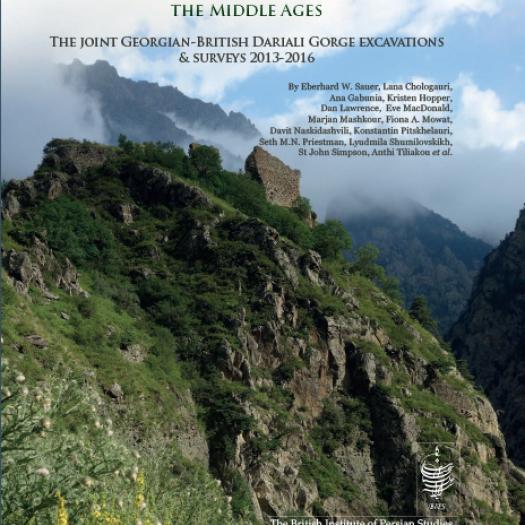L’archéologie de l’antiquité et des périodes médiévales de la Géorgie



Une nouvelle publication vient de paraître sur l’archéologie de l’antiquité et des périodes médiévales de la Géorgie. Ces deux volumes de 1088 pages, publiés chez Oxbow Books, marquent un jalon dans l’archéologie de la Géorgie par l’ampleur des informations recueillies pour la zone du grand Caucase. Un volumineux chapitre est consacré aux études archéozoologiques, réalisées avec la participation active de l’UMR 7209 - AASPE et le laboratoire de Bioarchéologie de l’Université de Téhéran. Un second chapitre traite de l’archéobotanique et inclut une étude palynologique.
Dariali: The ‹Caspian Gates› in the Caucasus from Antiquity to the Age of the Huns and the Middle Ages: The Joint Georgian-British Dariali Gorge Excavations and Surveys 2013-2016 [Hardback] Chapter 21. Herding and hunting in the highlands from the Sasanian to late medieval periods.
E. W. Sauer, L. Chologauri, A. Gabunia, K. Hopper, D. Lawrence, Eve MacDonald, M. Mashkour, F. A. Mowat, D. Naskidashvili, K. Pitskhelauri, S. M.N. Priestman, L. Shumilovskikh, S.J. Simpson, A. Tiliakou et al.
ISBN: 9781789251920 | Published by: Oxbow Books | Series: British Institute of Persian Studies Archaeological Monograph Series | Volume: 6 | Year of Publication: 2020 | Language: English 1088p, H297 x W210 (mm) 700 black and white & colour images
Abstract
The Huns, invading through Dariali Gorge on the modern-day border between Russia and Georgia in AD 395 and 515, spread terror across the late antique world. Was this the prelude to the apocalypse? Prophecies foresaw a future Hunnic onslaught, via the same mountain pass, bringing about the end of the world. Humanity’s fate depended on a gated barrier deep in Europe’s highest and most forbidding mountain chain. Centuries before the emergence of such apocalyptic beliefs, the gorge had reached world fame. It was the target of a planned military expedition by the Emperor Nero. Chained to the dramatic sheer cliffs, framing the narrow passage, the mythical fire-thief Prometheus suffered severe punishment, his liver devoured by an eagle. It was known under multiple names, most commonly the Caspian or Alan Gates. Featuring in the works of literary giants, no other mountain pass in the ancient and medieval world matches Dariali’s fame. Yet little was known about the materiality of this mythical place. A team of archaeologists has now shed much new light on the major gorge-blocking fort and a barrier wall on a steep rocky ridge further north. The walls still standing today were built around the time of the first major Hunnic invasion in the late fourth century – when the Caucasus defences feature increasingly prominently in negotiations between the Great Powers of Persia and Rome. In its endeavour to strongly fortify the strategic mountain pass through the Central Caucasus, the workforce erased most traces of earlier occupation. The Persian-built bastion saw heavy occupation for 600 years. Its multi-faith medieval garrison controlled Trans-Caucasian traffic. Everyday objects and human remains reveal harsh living conditions and close connections to the Muslim South, as well as the steppe world of the north. The Caspian Gates explains how a highly strategic rock has played a pivotal role in world history from Classical Antiquity into the twentieth century.
The second volume includes Specialist contributions: finds, building materials, biological and environmental evidence and scientific dating.
21.1. The archaeozoology of the Dariali Gorge pp.729-780
Marjan Mashkour, Sarieh Amiri, Homa Fathi, Roya Khazaeli, Karyne Debue, Delphine Decruyenaere, Sanaz Beizaee Doost, Benoît Clavel, Safoora Kamjan, Rusudan Jajanidze and Eberhard W. Sauer
21.2. Fish remains
Valentin Radu and Eberhard W. Sauer
21.3. Microvertebrates
Emmanuelle Stoetzel, Lyudmila Shumilovskikh, Karyne Debue, Michel Lemoine and Marjan Mashkour
With and Online Appendix 172 pages
21.1a. Distribution of animal bones in deposits of various trenches 1
Appendix 21.1b. Standard measurements for Sheep and Goat after Uerpmann and Uerpmann (1994)
Appendix 21.1c. Standard measurements after Helmer (1992) belonging to modern cattle from Camargue (France)
Appendix 21.1d. Measurements for Bos (cattle)
Appendix 21.1e. LSI for Bos (cattle)
Appendix 21.1f. Measurements for Caprinae (Sheep/Goat)
Appendix 21.1g. Measurements for Ovis (Sheep)
Appendix 21.1h. LSI for Ovis (Sheep)
Appendix 21.1i. Measurements for Capra (Goat)
Appendix 21.1j. LSI for Capra (goat)
Appendix 21.1k. Measurements for Sus scrofa (Boar/Pig)
Appendix 21.1l. Measurements for Equidae (Horse)
Bibliography
22. Plant remains
Lyudmila Shumilovskikh and Imogen Poole